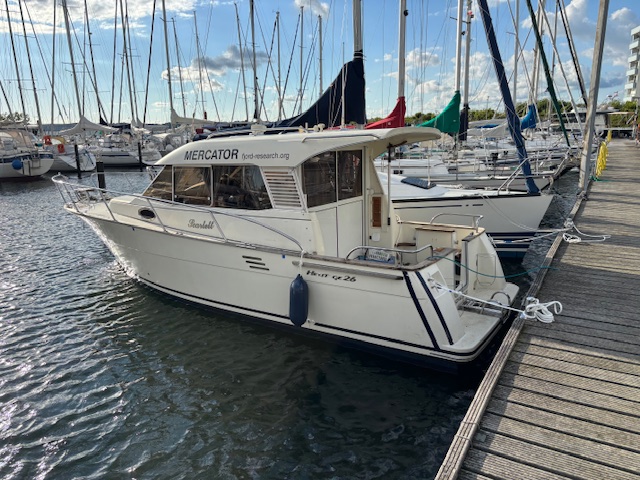
Water chemistry
The importance of water chemical monitoring of the Flensburg Inner Fjord
Introduction
Due to its geological characteristics, the Flensburg Inner Fjord is almost like an inland body of water. Across the relatively narrow channel in front of Holnishaken, there is hardly any significant water exchange between the outer and inner fjords. Thus, the inner fjord is almost entirely dependent on itself when it comes to dealing with the pollutants and nutrients introduced (eutrophication). The bottom of the inner fjord consists primarily of a layer of silt that can be up to several meters thick. This layer of silt consists of the decay products of so-called biogenic precipitation, such as dead algae. This silt accumulates particularly in the deeper regions of the fjord (up to 18 meters water depth) and in places with less favorable currents.
Therefore, two factors must be considered when assessing water quality:
1. The water body itself and
2. The near-bottom water layer.
This will require water samples to be collected at different depths at a single location in a timely manner.
 Our research boat "MERCATOR" is technically equipped for this purpose.
Our research boat "MERCATOR" is technically equipped for this purpose.
Some of the corresponding water analyses are conducted on board immediately after sampling. This involves recording the measured values of chemical compounds and physical properties that are considered variable, such as oxygen and temperature. Other analyses are performed in the water laboratory.
Proceedings
Five sampling locations have been defined in the Inner Fjord area. These locations will be visited chronologically to collect water samples from various depths. The data obtained will be stored in an archive and can thus be compared over a long period of time. The goal is to research how the various factors and chemical compounds change over the course of a year and over several years. The sampling locations will be visited four times a year, corresponding to the seasons.
The following values should be determined:
| Value | Abbreviation / Explanation | Unit of measurement |
| Sampling depth | Horizon in the water body | m |
| Salinity | Conductance | mS/cm |
| Temperature | Current water temperature | °C |
| ph-Value | Potential of hydrogen | |
| Dissolved oxygen | O2 | mg/l |
| Carbonate hardness | °dH | |
| Phosphate | PO4 | mg/l |
| Ammonium | NH4 | mg/l |
| Ammonia | NH3 | mg/l |
| Nitrite | NO2 | mg/l |
| Nitrate | NO3 | mg/l |
| Redox potential | ORP | mV/cm |
| Silicon oxide | SiO2 | mg/l |
| Magnesium | Mg | mg/l |
Conductivity, oxygen, and pH are measured electronically; all other measured values are determined using reagents. All procedures are standardized and scientifically verifiable.
Significance of the measurements
Water quality is of crucial importance for all organisms living in the body of water. The interaction of O2, PO4, NH3, NH4, NO2, NO3 and the redox potential is particularly important. Oxygen and the redox potential provide a direct indication of how well biogenic waste products are degraded. The role of NH3, NH4 and the pH value is less well known. Ammonia (NH3) is a highly toxic substance for all organisms. The tolerance of ammonium (NH4) is much higher. NH3 and NH4 form the so-called ammonia-ammonium complex. If the pH value is below neutral (pH 7), this complex is present in the form of ammonium as the water becomes increasingly acidic. However, if the pH value is above neutral, the complex shifts towards ammonia. In seawater, the pH value is usually in the alkaline range of 8.0-8.2. This is no different in the fjord.
The materialization of biogenic material is known as nitrification. Nitrification begins with phosphate (PO4). This is followed by NH3, NH4, NO2, and finally, at the end of the chain, nitrate (NO3), which returns to the cycle as fertilizer. Plants and algae in particular benefit from nitrate. Other important factors are water temperature and solar radiation. A summer with long periods of good weather, i.e. high temperatures and plenty of sunlight, leads to increased algae growth and thus more biogenic material after their death. If this is then accompanied by a long period of calm winds, i.e. low wave action and thus reduced oxygen input, these effects place a considerable strain on decomposition. A cool summer with reduced solar radiation and frequent strong winds has a supportive effect on the system, but on the other hand, the frequent rainfall causes increased nutrients and pollutants to enter the fjord via the streams. This eutrophication can, in turn, have a significant impact on biogenic decomposition.
Conclusion
It's clear that the interplay of the various factors is very complex. A change in one variable can have a significant impact on water quality. This also illustrates why monitoring as comprehensively as possible is so important in order to subsequently provide decision-makers with the information they need to act. This project is planned to run for several years. The findings and results will be regularly updated and published on our website.
22.07.2025 C.M.Hansen



